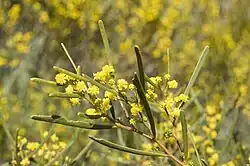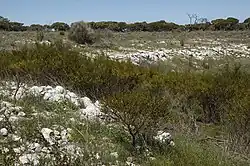Acacia cupularis
| Coastal umbrella bush | |
|---|---|

| |
| Scientific classification | |
| Kingdom: | Plantae |
| Clade: | Tracheophytes |
| Clade: | Angiosperms |
| Clade: | Eudicots |
| Clade: | Rosids |
| Order: | Fabales |
| Family: | Fabaceae |
| Subfamily: | Caesalpinioideae |
| Clade: | Mimosoid clade |
| Genus: | Acacia |
| Species: | A. cupularis
|
| Binomial name | |
| Acacia cupularis | |
| Synonyms[1] | |
|
List
| |

Acacia cupularis, commonly known as the coastal umbrella bush,[2] is a species of flowering plant in the family Fabaceae and is endemic to the south of continental Australia. It is an open to somewhat dense shrub with often dark reddish brown branchlets, linear, straight phyllodes, spherical heads of golden yellow flowers and more or less erect, crusty pods, appearing somewhat like a string of beads.
Description
Acacia cupularis is a glabrous, open shrub that typically grows to a height of 1–2.5 m (3 ft 3 in – 8 ft 2 in) and 2.5 m (8 ft 2 in) wide. The branchlets are often dark red-brown and covered with a white, powdery bloom. The phyllodes are asending to erect, straight, narrowly linear, 30–80 mm (1.2–3.1 in) long, 1–4 mm (0.039–0.157 in) wide and thick with two or three glands, the lower gland 3–14 mm (0.12–0.55 in) above the base of the phyllode. The flowers are borne in spherical heads in two or three racemes 1–7 mm (0.039–0.276 in) long on peduncles 2–6 mm (0.079–0.236 in) long, each head with 16 to 22 golden yellow flowers. Flowering occurs from July to December, and the pods are more or less erect, somewhat resembling a string of beads, up to 70 mm (2.8 in) long, 4–5 mm (0.16–0.20 in) wide, crusty and dark brown. The seeds are oblong, dull, light brown and 3–5 mm (0.12–0.20 in) long with an orange to scarlet aril.[2][3][4][5]
Taxonomy
Acacia cupularis was first formally described in 1923 by the botanist Karel Domin in Vestnik Kralovske Ceske Spolecnosti Nauk, Trida Matematiko-Prirodevedecke from specimens collected by Arthur Dorrien-Smith.[6][7] The specific epithet (cupularis) means 'resembling a cup', referring to the shape of the pods.[8]
This species is a member of the Acacia bivenosa group of wattles and is similar in appearance to A. maxwellii, A. crassiuscula and A. anceps x A. nematophylla.[3]
Distribution
This species of wattle is widespread in coastal and near-coastal areas from near Albany in southern Western Australia through South Australia[9] to the Victorian boarder and inland as far as Dimboola[10] in western Victoria and Three Springs in Western Australia. Its grows in sand or in loam or sandy clay in mallee communities.[2][5]
Conservation status
Acacia cupularis is listed as critically endangered under the Victoria Government Flora and Fauna Guarantee Act 1988.[10]
See also
References
- ^ a b "Acacia cupularis". Australian Plant Census. Retrieved 11 August 2025.
- ^ a b c Chapman, Arthur R.; Maslin, Bruce R. Kodela, Phillip G. (ed.). "Acacia cupularis". Flora of Australia. Australian Biological Resources Study, Department of Climate Change, Energy, the Environment and Water: Canberra. Retrieved 11 August 2025.
- ^ a b "Acacia cupularis". World Wide Wattle. Western Australian Herbarium. Retrieved 29 April 2019.
- ^ "Acacia cupularis"". Australian Biological Resources Study. Retrieved 11 August 2025.
- ^ a b "Acacia cupularis". FloraBase. Western Australian Government Department of Biodiversity, Conservation and Attractions.
- ^ "Acacia cupularis". APNI. Retrieved 11 August 2025.
- ^ Domin, Karel (1923). "New Additions to the Flora of Western Australia". Vestnik Kralovske Ceske Spolecnosti Nauk, Trida Matematiko-Prirodevedecke. 2: 45. Retrieved 12 August 2025.
- ^ George, Alex S.; Sharr, Francis A. (2023). Western Australian Plant Names and Their Meanings - A Glossary (fifth ed.). Kardinya: Four Gables Press. p. 178. ISBN 9780645629538.
- ^ "Acacia cupularis". Seeds of South Australia. Retrieved 12 August 2025.
- ^ a b Entwisle, Timothy J.; Maslin, Bruce R.; Cowan, Richard S.; Cowan, Arthur B.; Stajsic, Val. "Acacia cupularis". Royal Botanic Gardens Victoria. Retrieved 12 August 2025.